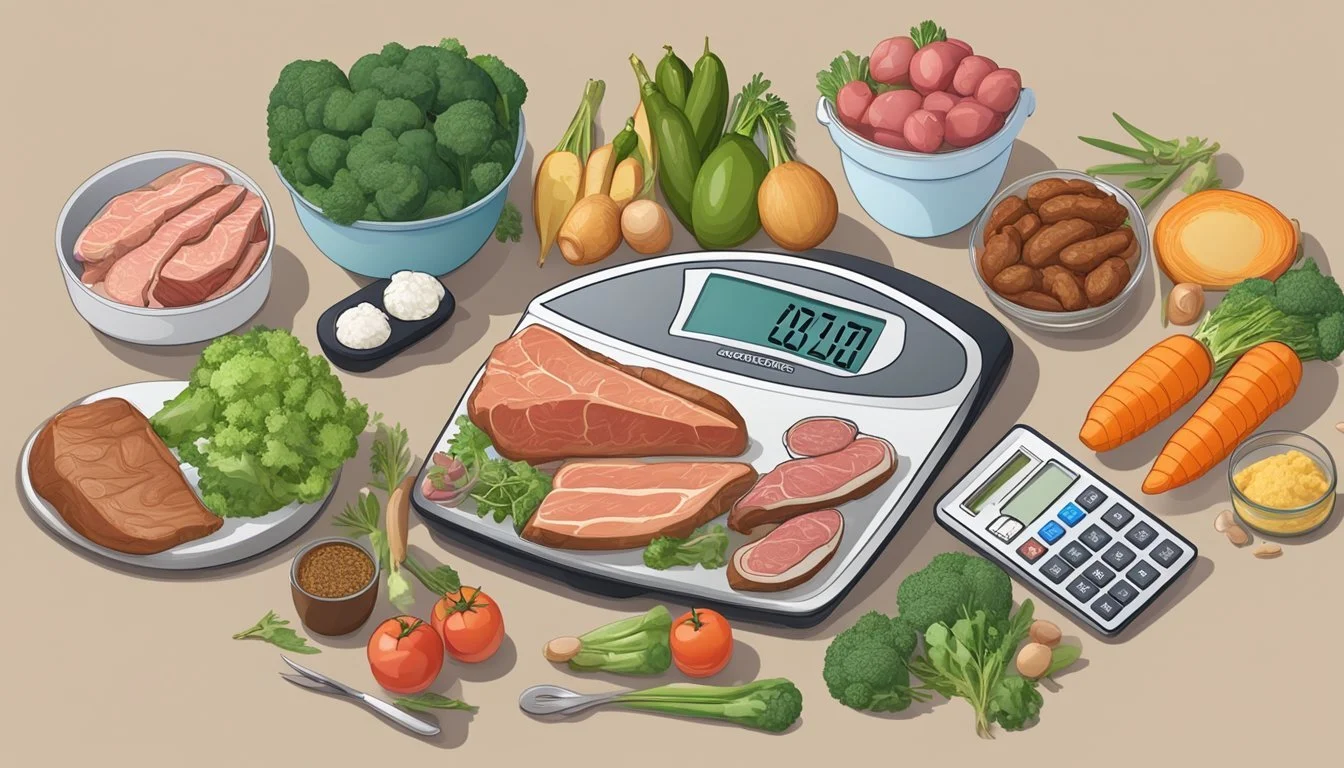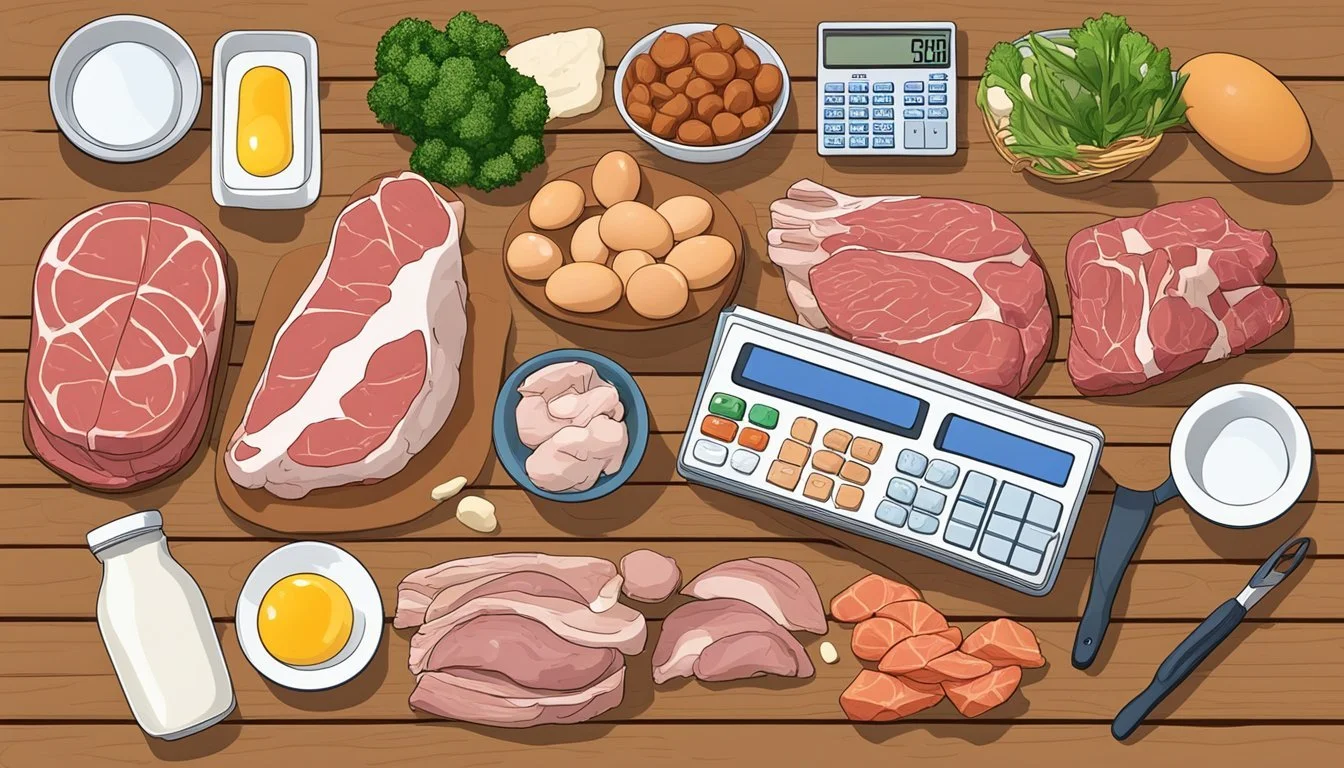Carnivore Diet Calculator
Your Guide to Zero-Carb Eating
This Article is Part Of Our Guide on the Carnivore Diet
The carnivore diet, a regimen centered around consuming primarily animal products, is gaining traction among those seeking health and weight loss benefits. Proponents argue that this diet leads to improved body composition and increased energy levels by aligning with the presumed eating patterns of ancestral humans. To optimize the diet for health goals and ensure adequate nutrient intake, individuals often use carnivore diet calculators. These tools assist in determining the correct balance of macronutrients—protein and fats—since carbohydrates are typically minimized or eliminated on this diet.
Tailoring nutrient intake is crucial, especially in a diet with such restricted food groups. A carnivore diet calculator evaluates personal factors such as goal weight, activity level, and unique health objectives. It then provides a customized macro breakdown to help adherents reach their desired outcomes, whether it's fat loss, muscle gain, or maintenance of a healthy weight. The guidance from these calculators is often grounded in nutritional research and adjusted for practical experience, which may offer individuals a structured approach to navigate what might otherwise be an overwhelming shift in eating habits.
Health considerations are paramount when adopting a diet consisting solely of animal products. A carnivore diet calculator serves as a starting point to ensure that one's diet is nutritionally adequate and supports their overall well-being. By leveraging such tools, individuals can make informed decisions about their eating patterns and take control of their health journey with confidence.
Understanding the Carnivore Diet
This section provides an insight into the carnivore diet, comparing it to other nutritional strategies, and assessing its health implications based on its macro composition.
Definition and Core Principles
The carnivore diet is an eating plan that consists entirely of animal products and is void of plant-based foods. It focuses on meats, organ meats, eggs, and sometimes dairy, while completely eliminating carbohydrates, fiber, and plant foods. This diet operates on the principle that animal products provide all the essential vitamins, minerals, protein, and fat required by the human body.
Macros on a carnivore diet typically include:
High protein: Essential for body repair and muscle growth.
High fat: Serves as the primary energy source in the absence of carbs.
Zero carbs: No fruits, vegetables, grains, or legumes consumed.
Comparison with Other Diets
The carnivore diet stands in stark contrast to most traditional dietary guidelines which often include a balance of plant and animal sources. Compared to a ketogenic diet, which also reduces carbohydrate intake, the carnivore diet tends to be even lower in carbs and excludes all plant-based fiber and foods. Unlike mixed-food diets, the carnivore diet limits diversity, instead focusing on nutrient-dense animal products.
Potential Health Benefits and Risks
Individuals may experience weight loss and improved blood sugar regulation due to the low-carb nature of the carnivore diet -- effects often seen in ketogenic diets. However, as the diet excludes a variety of food groups, there may be risks of nutritional deficiencies in vitamins, minerals, and fiber found predominantly in plant foods. Additionally, the high intake of saturated fat and protein has raised concerns regarding potential impacts on heart and kidney health. It is crucial for individuals to monitor their health carefully and consider supplementation if they choose to follow this diet.
Carnivore Diet Macronutrients
In a carnivore diet, the focus is primarily on consuming animal-based foods which heavily affects the way macronutrients are balanced. The diet essentially comprises almost entirely of proteins and fats, with a minimal presence of carbohydrates.
Proteins in Focus
Proteins are the cornerstone of the carnivore diet, predominantly found in meat, such as beef and pork, and organ meats like liver. These foods provide essential amino acids crucial for body functions. Eggs and fish, including salmon, tuna, and mackerel, are also high in protein and are staples in this diet.
Role of Fats
Fats provide a majority of the calories in a carnivore diet. Sources such as beef and pork contain saturated fat, while fish offers essential fatty acids, including omega-3s. Bacon, cheese, and the fat in meat are utilized for energy and to aid in the absorption of fat-soluble vitamins.
Minimizing Carbohydrates
In contrast to traditional diets, the carnivore diet minimizes the intake of carbohydrates to near zero as it excludes plant-based foods. Animal products inherently contain very few carbohydrates, with the occasional trace amounts found in items like cheese and certain seafoods.
Calculating Your Carnivore Diet Macros
When embarking on a carnivore diet, individuals must determine their caloric needs and appropriate macro ratios to meet their health and fitness goals. The use of a macros calculator can facilitate this process by tailoring to one's specific body weight, height, age, and gender.
Determining Caloric Needs
To calculate macros effectively, one first needs to determine their total daily caloric needs, which is contingent on several factors including body weight, age, height, gender, and activity level. Sedentary individuals generally require fewer calories, while those with higher levels of physical activity may need more to support their energy expenditure. Calorie calculators typically employ an equation factoring in these variables to estimate the number of calories needed to maintain current body weight.
Example Caloric Need Equation:
Calories/day = Basal Metabolic Rate (BMR) × Activity LevelMacro Ratios for Carnivore Diet
Macros on a carnivore diet mainly consist of fat and protein intake, as carbohydrate consumption is negligible. The suggested distribution typically leans towards a higher percentage of calories from fat, given its energy-dense nature. Here, the focus is to calculate macros that suit a diet predominantly consisting of meat, with an emphasis on meeting protein needs while adjusting fat intake to reach the necessary calorie count.
Recommended Macro Ratio:
Protein: Moderate to high intake to support muscle maintenance and growth
Fat: High intake to provide the majority of daily calories
Carbohydrates: Minimal to none
Making Adjustments for Goals
Individual goals such as weight loss, muscle gain, or body recomposition will require tailored adjustments to caloric intake and macro ratios. For a calorie deficit conducive to fat loss, one might reduce overall caloric intake while maintaining high protein to preserve muscle. Conversely, someone aiming for weight or muscle gain may increase their caloric surplus, thus adjusting fat and protein intake accordingly. Regular consultation with a healthcare professional or dietitian can provide guidance and ensure nutritional adequacy and safety. It is crucial to monitor one's progress and adjust the macro/calorie calculator inputs as goals evolve.
Goal Based Adjustments:
Weight Loss: Maintain high protein, create a calorie deficit
Muscle Gain: Increase calorie surplus, ensure adequate protein
Maintenance: Adjust to maintain current body composition
Regular evaluation and recalibration of one's macro and calorie allocation are essential to maintaining alignment with personal health goals and activity levels.
Food Choices on a Carnivore Diet
Making the right food choices is crucial on a carnivore diet, focusing on animal products and excluding plant-based foods to meet nutritional needs.
Recommended Foods
The carnivore diet emphasizes the consumption of high-quality animal proteins and fats. Followers of the diet should prioritize:
Proteins:
Beef: Grass-fed and finished cuts like ribeye, sirloin or ground beef.
Poultry: Chicken and turkey, ideally free-range or organic.
Pork: Pork chops, (What wine goes well with pork chops?) pork belly, and other cuts.
Fish: Fatty fish such as salmon and tuna; white fish is also acceptable.
Eggs: Including both chicken and duck eggs, prepared as hard-boiled eggs or cooked in fats like butter.
Organ Meats: Nutrient-dense items such as liver, kidneys, and heart from various animals like beef, lamb, and chicken.
Fats:
Animal Fats: Butter, ghee (how long does ghee last?) (clarified butter), and fats rendered from meats.
Dairy Fats: Hard cheeses in moderation, provided tolerance is good.
Other:
Bone broth, which is nutrient-dense and can be made from beef, chicken, or fish bones.
Foods to Avoid
Individuals on the carnivore diet should avoid all plant-based foods. Avoidance includes but is not limited to:
Grains of any kind
Fruits and vegetables
Nuts and seeds
Legumes
Sugars and sweeteners
Vegetable oils and trans fats
Processed foods and additives
Sticking solely to animal-based foods is essential to adhere to the carnivore diet principles.
Effects of the Carnivore Diet on Body Weight
The carnivore diet, which emphasizes the consumption of meat and animal products, has distinct implications for body weight management, including its potential for weight loss and changes to muscle mass and body composition.
Impact on Weight Loss
Individuals on the carnivore diet may experience weight loss primarily as a result of a calorie deficit induced by high levels of satiety from protein intake. The diet's restriction of carbohydrates forces the body to utilize fat stores for energy, which can lead to a decrease in body weight. Additionally, some proponents suggest that the diet's simplicity aids in mindful eating, possibly eliminating unnecessary caloric intake.
Influence on Muscle Mass and Body Composition
Regarding muscle mass, the carnivore diet's high protein content can be beneficial for muscle synthesis and maintenance. Adequate protein is crucial for repairing and building muscle tissue, especially when combined with resistance training. Moreover, a diet high in protein and low in carbohydrates may contribute to a better body fat percentage by preserving lean mass while reducing body fat. However, individual results can vary based on activity levels, overall caloric intake, and personal metabolism.
Health Considerations and Monitoring
When adopting a carnivore diet, it is crucial to consider health implications and meticulously monitor one's wellbeing. It involves seeking medical advice, evaluating essential health markers and nutritional intake, and addressing any potential inflammatory or digestive issues.
Consulting Healthcare Professionals
Individuals should consult with healthcare professionals before starting a carnivore diet to ensure it is appropriate for their health condition. Medical experts can provide essential guidance on potential risks such as nutrient deficiencies or protein poisoning, which can occur from an excessive intake of proteins without a proper balance of fat. They also help in understanding the importance of essential vitamins and minerals and how to maintain cellular health, specifically cell membrane integrity which relies on a variety of amino acids and fats.
Tracking Health Markers and Nutrition
Monitoring health metrics is essential for anyone on a carnivore diet. They should track the intake of macro and micronutrients to prevent deficiencies.
Key Health Markers to Monitor:
Blood pressure
Blood sugar levels
Key nutrient levels (e.g., vitamins D and B12, calcium, magnesium)
Tracking these metrics over time helps in identifying any nutrition-related issues early on. Keeping a detailed food log can be helpful in managing the intake of essential vitamins and minerals.
Managing Inflammation and Digestive Health
The carnivore diet can alter one's gut microbiota, which might require careful monitoring of digestive health. It is important to note any changes in digestion or signs of inflammation. Some individuals may experience an initial increase in inflammation due to high consumption of red meat; others may find relief from inflammatory conditions.
Methods to Manage Digestive Health and Inflammation:
Incremental dietary shifts: Gradually introduce the carnivore diet to allow the digestive system to adapt.
Regular health check-ups: Ensure that no adverse effects are developing due to the diet.
Hydration: Consume enough water to aid digestion and kidney function.
Individuals need to be vigilant about monitoring their health and should be ready to adjust their dietary practices to align better with their body’s needs.
Performance and Lifestyle
When leveraging a carnivore diet calculator, individuals seek to optimize their dietary approach to support fitness goals and integrate smoothly into daily life. Key components include managing activity levels, adapting fat-centric nutritional intake, and navigating social settings.
Enhancing Athletic Performance
For athletes and fitness enthusiasts, tailoring macros to support sports performance is crucial. Muscle growth and recovery hinge on adequate protein intake, making it imperative to calculate an individual's need based on their activity level. The carnivore diet typically prescribes a high intake of protein and fats, which may be beneficial for sustained energy during athletic pursuits. For instance, calculating the appropriate amount of lard or tallow consumed in each fat meal can be crucial for maintaining energy levels without compromising performance.
Adapting to a High-Fat Lifestyle
A carnivore diet is inherently high in fats. Individuals must adapt their metabolism to efficiently process these fats for energy—an adjustment that can be supported by a carnivore diet calculator. Proper fat intake is vital to ensure the body becomes proficient in using fat as a primary energy source. It may take time for one to adapt, but a careful balance of fats and macros is necessary for a healthy transition without overwhelming the body.
Daily Life and Social Situations
Incorporating a carnivore diet into one's daily routine extends beyond nutritional calculations. It also encompasses managing social settings where dietary choices may be challenged. It's important to plan for situations such as dining out or attending social events. Individuals should be aware of available options that adhere to a high-fat, carnivore approach, and make accommodations as needed to align with their calculated dietary needs.
Special Considerations
When utilizing a carnivore diet calculator, individuals must account for factors unique to their biological makeup and lifestyle. These considerations can significantly impact daily caloric and macronutrient requirements.
For Women
Women may require a different approach to the carnivore diet due to hormonal fluctuations and potential requirements during different life stages, such as pregnancy or menopause. Their Basal Metabolic Rate (BMR) is calculated:
BMR for Women: 447.593 + (9.247 x weight in kg) + (3.098 x height in cm) - (4.330 x age in years)
Use this formula to adjust intake according to individual needs, activity level, and health goals.
For Men
Men generally need more calories than women. This is due to various factors including higher muscle mass on average and different hormonal balances. Their BMR calculation:
BMR for Men: 88.362 + (13.397 x weight in kg) + (4.799 x height in cm) - (5.677 x age in years)
The resulting number should be modified by the activity level to estimate Total Daily Energy Expenditure (TDEE).
Aging and the Carnivore Diet
As individuals age, their metabolism slows down, which affects their caloric needs. Older adults may need fewer calories, and their protein requirements may increase to help preserve muscle mass. A nutrient-dense approach with adequate protein while managing fat intake forms the crux of the carnivore diet for aging populations.








